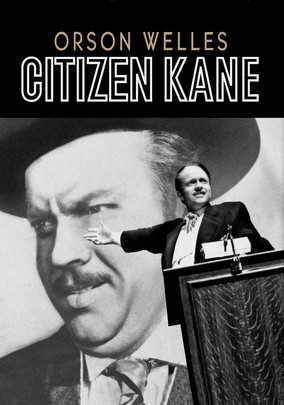 Bernard Herrmann is well known to have largely avoided the technique of leitmotif, which by the late 1930s had become a staple of Hollywood film music, especially in the scores of Max Steiner and Erich Korngold. But clearly Herrmann felt differently in writing his score for Citizen Kane, as he admitted that
Bernard Herrmann is well known to have largely avoided the technique of leitmotif, which by the late 1930s had become a staple of Hollywood film music, especially in the scores of Max Steiner and Erich Korngold. But clearly Herrmann felt differently in writing his score for Citizen Kane, as he admitted that
although I am not a great believer in the technique of the “leit-motiv” for motion picture music, the nature of this film demanded some “leit-motivs’”in linking together the various time juxtapositions. The most important motif—that of Kane’s power—is given out in the very first two bars heard. The second motif which should give away the secret of “Rosebud” is also heard early in the film.
The “power” motive is a very familiar motive in the film since it is heard so many times throughout. This motive, however, is virtually identical to a prominent theme in Rachmaninoff’s symphonic poem, The Isle of the Dead. For a composer as steeped in the classical musical tradition as Herrmann, such a relationship can hardly be coincidental. Also, the second of Herrmann’s motives, the “Rosebud” motive, is itself a transformation of the “power” motive, so both motives seem to derive from Rachmaninoff’s theme. But why might Herrmann have created these relationships? I give my thoughts below in a film music analysis.
The “Power” Motive
This motive is five notes long and in its initial form outlines the interval of the tritone, which lends the theme a dark, sinister character:
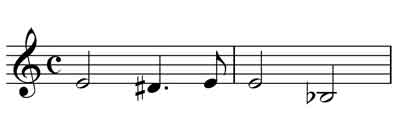 As Herrmann says, we hear this motive with the film’s opening shots, those of Xanadu, Kane’s enormous estate filled with unusual and lavish items he has collected over the years. The motive is actually played twice successively as the camera pans up the estate’s gate with the “No Trespassing” sign. Hear it in this clip from 0:33:
As Herrmann says, we hear this motive with the film’s opening shots, those of Xanadu, Kane’s enormous estate filled with unusual and lavish items he has collected over the years. The motive is actually played twice successively as the camera pans up the estate’s gate with the “No Trespassing” sign. Hear it in this clip from 0:33:
The motive often appears with the last note changed to form the smaller interval of a third:
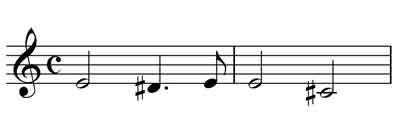 We hear this form of the motive in the famous “Breakfast Montage” (from 1:48):
We hear this form of the motive in the famous “Breakfast Montage” (from 1:48):
Rachmaninoff’s Theme
Now compare this motive to Rachmaninoff’s theme from The Isle of the Dead (transposed to the same key for comparison):
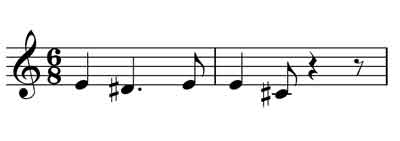 Hear it below at 3:17, 11:02, and 18:02 (among many other locations):
Hear it below at 3:17, 11:02, and 18:02 (among many other locations):
Not only are the notes the same as Herrmann’s second form of the power motive, but the rhythm and orchestration with muted brass instruments (at 3:17 in the clip above) are also incredibly similar. The resemblance is striking enough to suggest that Herrmann had this theme in mind when writing Citizen Kane.
The “Dies Irae” Chant
The origins of the power motive run even deeper—Rachmaninoff’s theme is shaped from the first four notes of the chant known as the “Dies Irae” (“day of wrath”), which is part of the Catholic Requiem Mass (again, transposed to the same key for comparison):
Rachmaninoff had something of an obsession with this chant, as he incorporated it into several of his works including the Second Symphony, the Symphonic Dances, and here in The Isle of the Dead.
Being a quotation of Rachmaninoff’s theme, Herrmann’s power motive therefore draws on the Dies Irae as well. But why quote Rachmaninoff? Why not just quote the chant directly? Well, the chant does not have its own set rhythm, as is the case with all old chants like this one. Herrmann’s borrowing of Rachmaninoff is likely a way of keeping the association with the chant while giving the motive a rhythm that makes it more recognizable. But then, why the association with the chant in the first place?
An Interpretation
The Power Motive
The text of the Dies Irae chant is all about the Day of Judgement, when devout Christians will rise to heaven while the “cursed” will be “sentenced to acrid flames”. Herrmann’s allusion to the chant is therefore a commentary on Kane’s morality: by evoking the Dies Irae, the power motive signals a condemnation of Kane’s actions, and indeed this is how it is generally associated with Kane throughout the film. In the clip of the breakfast montage above, for example, we hear the motive in the growling brass when Kane rudely finishes his wife’s sentence, saying that, by printing his opinions in his newspaper rather than actual fact, people will think “what I tell them to think”. This drives Kane and his wife further apart and towards their ultimate divorce.
There are plenty of other examples of this theme’s association with Kane’s selfish lust for power and the negative connotations it entails:
- When the reporter, Thompson, arrives at the library to read the diary of Thatcher, who was Kane’s guardian and a heavy influence in the development of Kane’s greed (the power motive is heard right at the start of the clip in slightly varied form):
- The bankruptcy of Kane’s newspaper business and his admission that he never made a single investment, but only used his money “to buy things” (heard at 0:23 in the following clip):
- When we are introduced to Kane’s years at the Inquirer newspaper, where he slowly becomes corrupted by greed (here, the motive is part of a larger ragtime march by Herrmann – at 0:03 in the muted trumpets, and at 0:18 in clarinets):
The Rosebud Motive
Herrmann emphasizes the power motive’s association with condemnation by contrasting it with the other prominent leitmotif in the score—the one for Rosebud:
Like the power motive, The Rosebud motive contains five notes and is nearly identical in rhythm. But its contour is very much the opposite of the power motive. And instead of a tritone or minor third, it ends with a falling fourth, which gives the motive a much brighter, even hopeful sound.
This motive is associated with the more positive influences in Kane’s life, most of all the sled, Rosebud, which symbolizes his lost childhood and the resulting unhappiness he has felt ever since.
As Herrmann himself says, the meaning of the word Rosebud, around which the entire film hinges, is actually given away through the music well before it is revealed in the images. The motive is heard just after Kane utters his final word, “Rosebud”, then is heard again when we see Kane as a young boy playing in the slow with the sled.
Hear it in this flashback scene from 0:09:
The motive is also heard in relation to another positive influence in Kane’s life, Susan, his second wife. Hear it in the following scenes:
- Kane’s first meeting with Susan (from 0:19):
- Kane after Susan leaves (from 2:30):
Taken together, the Rosebud and power motives suggest the basis of Kane’s psychology—the lost happiness of childhood that he attempts to replace with all the material goods that money can buy. Herrmann establishes this relationship musically at the start of the film by juxtaposing the two motives in the very opening scene. Listen a final time to the music of this scene (from 0:33) and note the appearances of the two motives at the following times:
0:33 – Power (muted brass)
0:44 – Power (muted brass)
0:55 – Rosebud (same muted brass as the power motive, already suggesting their connection)
1:34 – Rosebud (hauntingly in the vibraphone)
2:03 – Power (muted brass)
2:14 – Rosebud (flute)
2:47 – Power (muted brass)
2:55 – Rosebud (flute)
These kinds of intricate details in Herrmann’s score certainly contribute to the widely-held belief that Citizen Kane as a whole is one of the greatest films—if not the greatest—ever made.
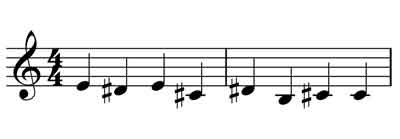

This is incredibly helpful. Does anyone know an online resource where I could find an electronic version of the prelude from CK? if so please write music @ jeremymage dot com . . . thanks!!!!!
yes, you nailed it. I remember that scene in the library, where Joseph Cotton is researching Kane. The Isle of the Dead theme is blasted out, loudly, on horns
Thanks, Haxo. Your comment’s much appreciated!
Just came across your focused analysis. You might already know this, but Herrmann himself stated that the “destiny” (power) motif to him was “a sort of variant on the ancient hymn ‘Dies Irae'”.
However, regarding the use of the Rosebud motif I have always believed that it appears in the Susan scenes not because Susan was a positive influence (meeting her starts the downward spiral after all) but because of her snow globe that reminds him of his hermetically sealed childhood.
Very useful, thanks! I especially appreciated grasping how the two motifs are worked together during the opening death scene. Also, I was able to get that the R motif on the flute here, is repeated, on the flute, when Kane meets Susan and then after she leaves.
There is a brilliant essay on the score for CK written by the French Welles scholar, Francois Thomas. Unfortunately, I can’t locate it since I’m away from my CK library. But a netsearch should turn it up.